Kenya Safari
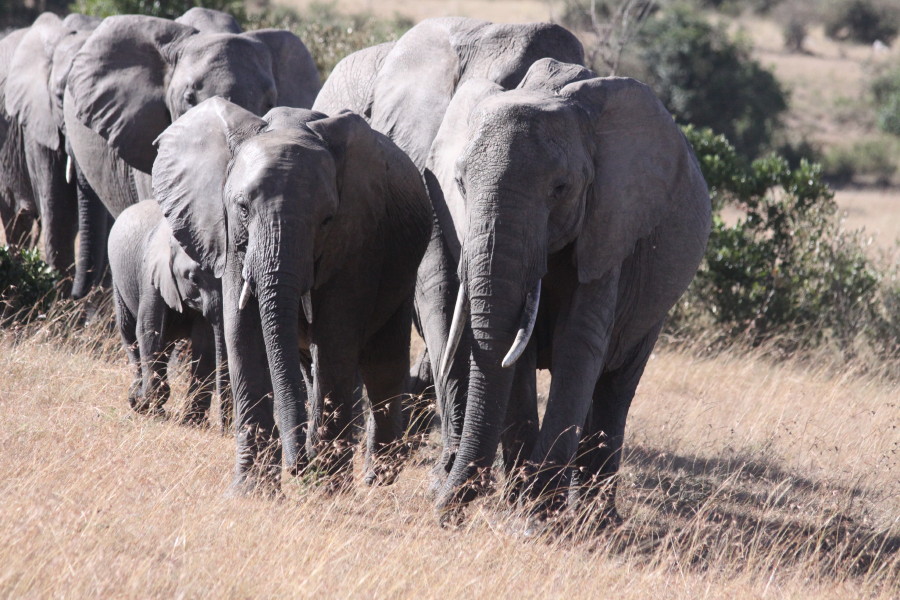 During February 2012, I was fortunate to be able to spend 10 days on safari in Kenya. This was a first for me and quite an adventure. We took an overnight flight from Heathrow Airport arriving in Nairobi, East Africa, at around 6 am the following morning. The Stanley Hotel in Nairobi was our base for a couple of days, which helped us to acclimatise after the 9 hour flight from Heathrow.
During February 2012, I was fortunate to be able to spend 10 days on safari in Kenya. This was a first for me and quite an adventure. We took an overnight flight from Heathrow Airport arriving in Nairobi, East Africa, at around 6 am the following morning. The Stanley Hotel in Nairobi was our base for a couple of days, which helped us to acclimatise after the 9 hour flight from Heathrow.
After lunch on our first day in Nairobi we visited the 'Giraffe Centre' on the outskirts of the city, where considerable work has and is being done to safeguard the future of the Rothschild Giraffe, which had been heavily persecuted as the result of land redevelopment. The centre provides education for the Kenyan children and teaches them about their country's wildlife and environment. The centre has been built on a 120 acre site and has a purpose built lecture hall and a 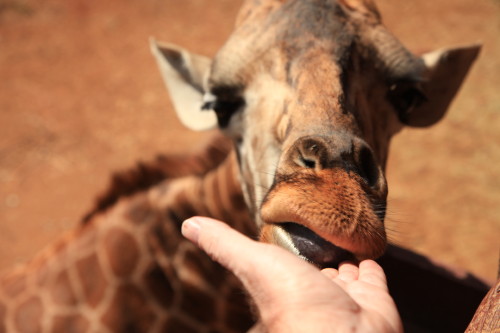 stunning raised viewing gallery, where you can literally hold out your hand and the Giraffe's will come and lick your hands. Whilst there the wardens gave an excellent presentation about the three types of giraffe found in the parks, The Rothschild, Masai Giraffe and the Reticulated Giraffe. The centre has a full breeding programme and all the young calves born there are released back into the wild as soon as they have been weaned from their mother. All the Giraffes at the centre are closely monitored and guarded by a dedicated team of staff. The centre is run on a non profit making basis and was founded in 1979.
stunning raised viewing gallery, where you can literally hold out your hand and the Giraffe's will come and lick your hands. Whilst there the wardens gave an excellent presentation about the three types of giraffe found in the parks, The Rothschild, Masai Giraffe and the Reticulated Giraffe. The centre has a full breeding programme and all the young calves born there are released back into the wild as soon as they have been weaned from their mother. All the Giraffes at the centre are closely monitored and guarded by a dedicated team of staff. The centre is run on a non profit making basis and was founded in 1979.
Later that afternoon we continuing our journey around Nairobi, and drove to a small village called 'Karen' to look around the Kazuri workshop. This centre was founded in 1975 by Lady Susan Wood in order to create employment for the increasing numbers of single mothers in this area. As well as providing employment for the girls it also provides them with education, medical and nursery care. In the workshop the girls are employed making clay jewellery - necklaces and bangles. The clay is moulded into the required shape and size, fired in the kiln and hand painted, quite a lengthy and time consuming business, but the finished product is of such a high standard that they are exported all around the world. Kazuri jewellery can be found in many of the shops here in York and around Yorkshire.
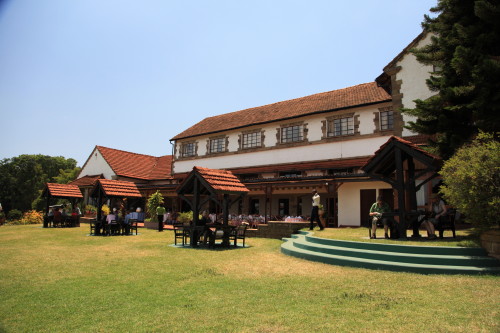 The following day we left the hustle and bustle of the Stanley Hotel in Nairobi and drove to the Outspan Lodge a smart colonial type hotel in Nyeri for lunch. A beautiful lodge and an excellent lunch taken outside on the veranda in glorious sunshine, with magnificent views across the valley towards Mount Kenya. The reception area for the legendary Treetops Hotel is here but as the hotel was still being renovated that entire area was out of bounds.
The following day we left the hustle and bustle of the Stanley Hotel in Nairobi and drove to the Outspan Lodge a smart colonial type hotel in Nyeri for lunch. A beautiful lodge and an excellent lunch taken outside on the veranda in glorious sunshine, with magnificent views across the valley towards Mount Kenya. The reception area for the legendary Treetops Hotel is here but as the hotel was still being renovated that entire area was out of bounds.
One of the most famous former residents of Nyeri was Lord Baden Powell the founder of the Scout movement. He was born in London in 1857, and served in the British Army in India and Africa between 1876 and 1910, becoming Lieutenant General and gained several medals for his heroic efforts during the conflicts, the most notable in the Siege of Mafeking, in the Anglo Boer War of 1899 - 1902 . He retired from the Army at the request of King Edward V11 in 1910 to promote Scouting. Two years later he met his future wife Olave, later in charge of the Girl Guide Movement. He was knighted in 1921. Baden Powell and Olave moved to Nyeri in 1939 where they lived in a specially commissioned one bedroomed bungalow in the grounds of the Outspan Hotel from 1939 till his death in 1941. The bungalow, named 'Paxtu' has been turned into a small museum and is a must place to visit for any member of the Scout and Guide movement, past or present. When he died on the 8th January 1941 he was buried in Nyeri, facing Mount Kenya. Olave was buried alongside him in 1977. The joint grave is now a national monument.
After leaving the museum we made our way back to the landrover for the drive over to Mountain Lodge our next nights stay,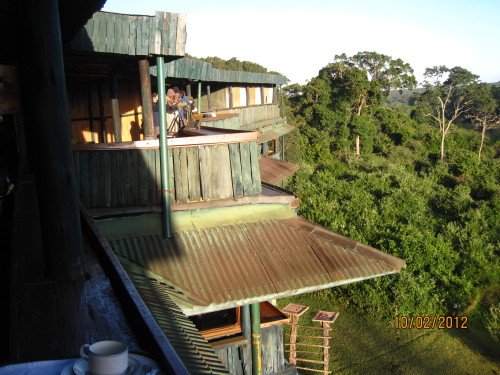 situated 7,200ft above sea level on the wooded slopes of Mount Kenya. This was quite a remarkable lodge, built amongst the trees, on stilts and constructed out of wood! The open air viewing area overlooked a watering hole that was used regularly by African Elephants, Cape Buffalo and a host of Monkeys, to name but a few. This upper level also doubled up as the restaurant so as we ate our evening meal we could watch the visiting wildlife at the same time, quite surreal really. Later that afternoon 'Benson' the resident guide took us (and our armed guard) for a walk around the watering hole and into the forest for a fascinating talk on the forest and the wildlife we were expected to see. Later that evening he gave an excellent slide and video presentation of the local wildlife. The lodge was extremely well furnished and all the onsuite bedrooms had a huge picture window overlooking the watering hole. It was quite amazing to just lay on your bed, look out of the window and see a whole host of animals running around outside the window. What a great place, needless to say we didn't get much sleep that night as our porters kept knocking on our door when certain animals visited the watering hole throughout the night!.
situated 7,200ft above sea level on the wooded slopes of Mount Kenya. This was quite a remarkable lodge, built amongst the trees, on stilts and constructed out of wood! The open air viewing area overlooked a watering hole that was used regularly by African Elephants, Cape Buffalo and a host of Monkeys, to name but a few. This upper level also doubled up as the restaurant so as we ate our evening meal we could watch the visiting wildlife at the same time, quite surreal really. Later that afternoon 'Benson' the resident guide took us (and our armed guard) for a walk around the watering hole and into the forest for a fascinating talk on the forest and the wildlife we were expected to see. Later that evening he gave an excellent slide and video presentation of the local wildlife. The lodge was extremely well furnished and all the onsuite bedrooms had a huge picture window overlooking the watering hole. It was quite amazing to just lay on your bed, look out of the window and see a whole host of animals running around outside the window. What a great place, needless to say we didn't get much sleep that night as our porters kept knocking on our door when certain animals visited the watering hole throughout the night!.
The following day it was on to Lake Nakuru National Park, situated in the Great Rift Valley. Lake Nakuru lies some 90 miles north west from Nairobi. The township of Nakuru was originally the centre of a booming agricultural industry in Kenya, as 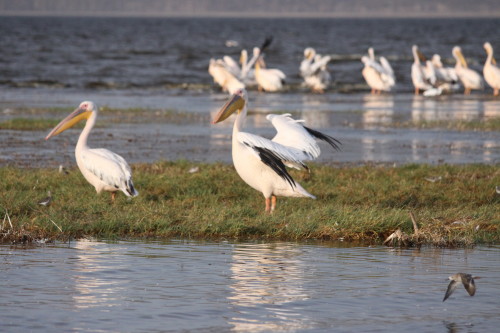 agriculture lost its position to horticulture so the importance of Nakuru waned, but the township is probably third in size to Nairobi and Mombasa.
agriculture lost its position to horticulture so the importance of Nakuru waned, but the township is probably third in size to Nairobi and Mombasa.
The Lake Nakuru itself is a haven for thousands of birds. I was amazed at the sheer size and variety of bird life here. There are over 500 different varieties of bird recorded at Lake Nakuru.We were advised by our guide that there were supposed to be around 2 million Flamingo settled on the lake, alas we didn't see one. We did see plenty of White Pelicans and Yellow Billed Storks though which more than made up for a few Flamingo's. Apparently there are very few fish in the lake, due to the high levels of alkali in the water, this encourages the growth of algae which is what the Flamingo's feed off. The ecology of the lake seems to have changed somewhat though, since the introduction of an alkali tolerant Tilapi from Lake Magadi in 1953. The Tilapi has thrived in this environment resulting with an influx of Pelicans. The lake is fed by three major rivers, the Makalia, the Njoro and the Enderit. This inflow is supplemented by a series of springs that rise along the shore line, what is 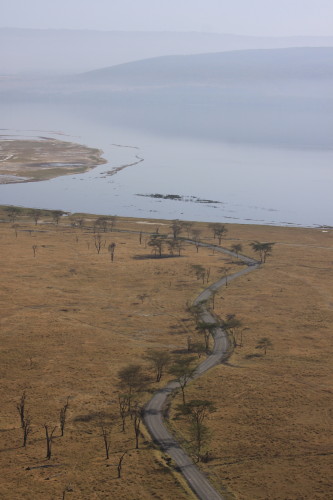 interesting to note is there is no known outlet, though scientists believe the water is seeping through slight fissures in the lakes floor. We left the lake and headed of for a game drive through the National Park. It was here we saw the White Rhino, They are a massive animal, much larger than the Black Rhino, weighing in at around 3,600kg. It was back in the 1990's that a dozen White and 20 Black Rhino were transported to Lake Nakuru. They have successfully bred and today there are around 50 pairs of each species. The rarer White Rhino tend to prefer the southern floodplains. There were plenty of Cape Buffalo and Plains Zebra grazing on the grasses, as it was getting dark we headed back to Nakuru Sopa Lodge. We stayed in a luxury cottage on the complex which had full onsuite facilities and huge double glazed patio sized sliding doors, which gave some amazing views onto the game reserve. As we walked from our room to the main lodge for our evening meal we watched the 'Super Starlings' flying amongst the trees, their blue colours glistening under the floodlights. The following morning we headed off for another game drive along the lake and spotted several large raptors amongst the trees including an African Wood Owl, Crowned Eagle and the Lizard Buzzard. During the drive we stopped at Baboon Cliff viewpoint and absorbed some magnificent views across the plains to the lake below. There were several Agama Lizards basking on the rocks, enjoying the sunshine. The Olive and Ververt Baboons were quite active and often seen walking with their young on their backs alongside the dirt tracks.
interesting to note is there is no known outlet, though scientists believe the water is seeping through slight fissures in the lakes floor. We left the lake and headed of for a game drive through the National Park. It was here we saw the White Rhino, They are a massive animal, much larger than the Black Rhino, weighing in at around 3,600kg. It was back in the 1990's that a dozen White and 20 Black Rhino were transported to Lake Nakuru. They have successfully bred and today there are around 50 pairs of each species. The rarer White Rhino tend to prefer the southern floodplains. There were plenty of Cape Buffalo and Plains Zebra grazing on the grasses, as it was getting dark we headed back to Nakuru Sopa Lodge. We stayed in a luxury cottage on the complex which had full onsuite facilities and huge double glazed patio sized sliding doors, which gave some amazing views onto the game reserve. As we walked from our room to the main lodge for our evening meal we watched the 'Super Starlings' flying amongst the trees, their blue colours glistening under the floodlights. The following morning we headed off for another game drive along the lake and spotted several large raptors amongst the trees including an African Wood Owl, Crowned Eagle and the Lizard Buzzard. During the drive we stopped at Baboon Cliff viewpoint and absorbed some magnificent views across the plains to the lake below. There were several Agama Lizards basking on the rocks, enjoying the sunshine. The Olive and Ververt Baboons were quite active and often seen walking with their young on their backs alongside the dirt tracks.
After lunch we headed for Lake Naivasha also in the Great Rift Valley. The lake is home to over 400 recorded bird species. The lake is a relatively shallow and circular in shape. The Gilgil and Malewa rivers flow into Naivasha's swampy northern shore, but there is no known outlet and the water probably stays fresh due to the subterranean outlet that emerges at Lake Magadi. We had a short drive along the lake and spotted plenty of .jpg) Pelecans, Marabou and Yellow Billed Stork. Later that afternoon we arrived at the Lake Naivasha Sopa Resort. A brilliant place to stay. Our accomodation for the next two nights was a large circular chalet which had huge sliding patio doors that opened onto a large veranda that had vast views onto the parkland. The short time we had there we watched the Giraffe, Waterbuck Hippo and Monkey. Our chalet was about 500 metres from the main part of the lodge and we were advised that during nightfall we had to be escorted to and from the lodge by 'armed guards' the guards were armed with wooden clubs and sticks to fend off the Hippos that would amble up from the lake to graze on the freshly watered grasses around the lodge and chalets. Hippos although rather large and docile looking are extremely agile and not particularly friendly if approached by strangers.
Pelecans, Marabou and Yellow Billed Stork. Later that afternoon we arrived at the Lake Naivasha Sopa Resort. A brilliant place to stay. Our accomodation for the next two nights was a large circular chalet which had huge sliding patio doors that opened onto a large veranda that had vast views onto the parkland. The short time we had there we watched the Giraffe, Waterbuck Hippo and Monkey. Our chalet was about 500 metres from the main part of the lodge and we were advised that during nightfall we had to be escorted to and from the lodge by 'armed guards' the guards were armed with wooden clubs and sticks to fend off the Hippos that would amble up from the lake to graze on the freshly watered grasses around the lodge and chalets. Hippos although rather large and docile looking are extremely agile and not particularly friendly if approached by strangers.
The next day we took a drive to Crescent Island Game Conservancy and a tour of the peninsula. Originally the rim of an extinct volcanic crater. Crescent Island encloses the deepest part of Lake Naivasha and is home to a variety of wildlife including Zebra, Wilderbeast and Waterbuck. Mumbo our guide took us for a walk along the peninsula and gave an interesting talk about the area and wildlife. After lunch we headed back to our chalet and spent a leisurely afternoon watching the wildlife from our balcony. It was quite amusing watching the Black and White Colobus Monkeys running and playing on the roof tops of the chalets.
The following morning we said a sad fairwell to Lake Naivasha Sopa Resort and drove into the Masai Mara Game Reserve. 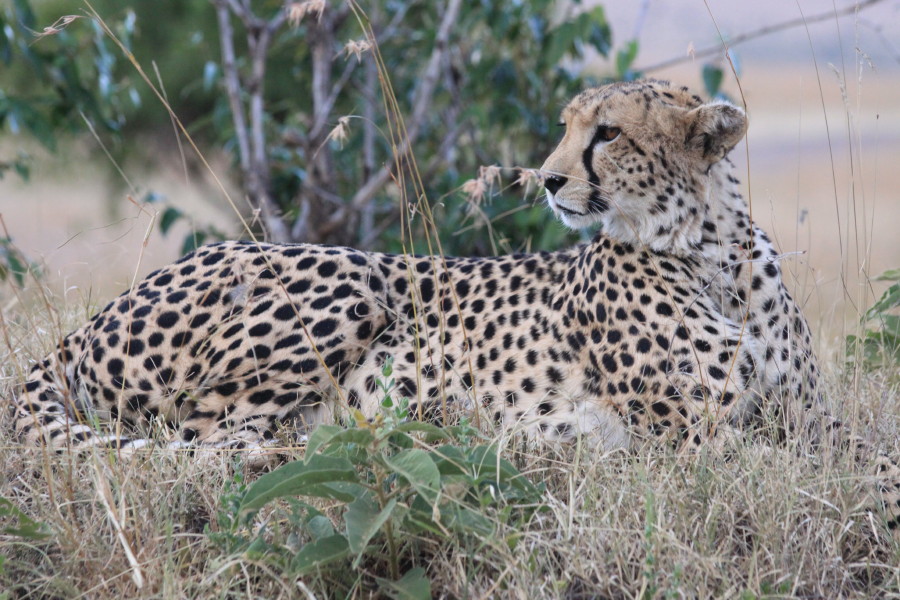
After lunch we set off on a late afternoon game drive through the Mara, We had several close encounters with the African Elephants as they walked past our vehicle. There were lots of Thompson Gazelle's grazing along with Plains Zebra, Cape Buffalo and Masai Giraffe. We only had a couple of fleeting glimpses of a lioness which was a bit dissapointing, but one of the many highlights of our first drive through the Mara was coming upon a female Cheetah and her Cub, resting on a turmite mound, wow. The mother Cheetah just layed there quite relaxed and oblivious to the passing vehicles and their passengers all anxious to get a photograph. It wasn't until we drove around the mound that we spotted the Cheetah cub, hard fast asleep out of the glare of the afternoon sun. That was the talking point for the rest of the evining back at the lodge.
Our second day in the Masai Mara and an early start. Today we visited a Masai Village. The chief of the tribe introduced himself 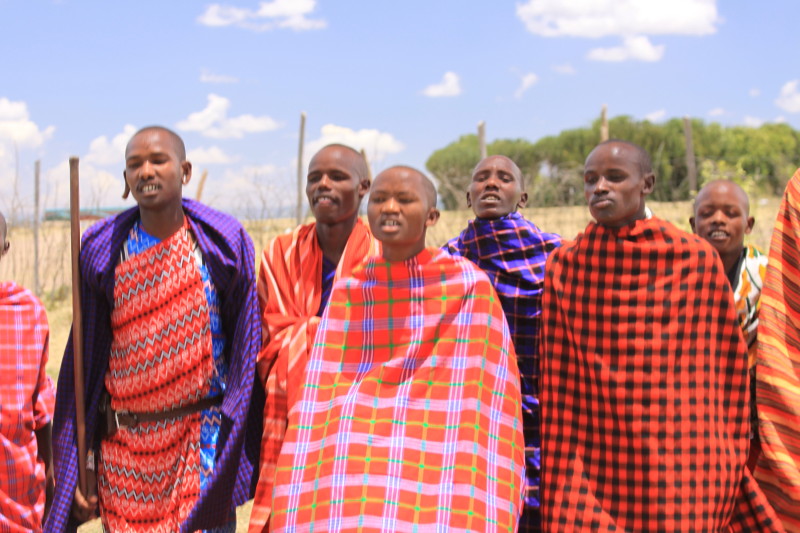 and his family. The women of the tribe did a ritual greeting dance that basically resembles pogoing, the skill of the dancer is measured by how high they can jump into the air.
and his family. The women of the tribe did a ritual greeting dance that basically resembles pogoing, the skill of the dancer is measured by how high they can jump into the air.
After the dance routines the warrior's showed us around their tiny mud hut homes which they shared with their cows and goats. Quite a humbling experience. The Masai Tribe are primarily cattle men, the wealth of the tribe is measured by the number of cattle they have. The conditions and environment in which these people lived in was quite remarkable.
From the Masai village we went into the local Primary School. The class rooms were extremely basic, a corrigated roofed building with flimsy walls and a couple of window, no electricity, a dry mud/earth floor, no air conditioning. It was not unusual for some of the children to walk upto 7 km to and from school daily! What was remarkable was that all the children were happy and seemed eager to learn, by the time they left Primary school at the age of 12 years, all the children could read and write fluently in their own language and also speak and write fluent English also! All the children and teachers were eager to speak to us and show us their work. They were quite passionate about football and knew most of the popular English Premiership players. We reluctantly left the children to their lessons and made our way back to the vehicles for a full day game drive in the Mara.
Our penultimate day and last day in the Masai Mara. Unbelievably warm, dry and dusty, watched plenty of Masai Giraffes feeding on the thorny branches and leaves of the Acacia Trees, looked high and low for Lion but to no avail. Zebra, Cape Buffalo and Black Rhino were plentyful. Today we had a picnic lunch under one of the Acacia Trees, and watched 3 Masai boys hearding their cows across the scrub land. After lunch we continued with the drive, and saw Thompson Gazelle, Impala, Spotted Hyena and Black Backed Jackal. In no time it was time to head back to our lodge prepare for our evening meal and an early night.
Final day and a long day. We left the Masai Mara Sopa Lodge at 6.30am for the long tortuous drive back to Niarobi and the Stanley Hotel, arriving around 1.30pm. Had a very pleasant late brunch in the Bisto. I still cannot understand the road network around this city nor the volume of traffic on the road. If ever a bypass was needed! We had a relaxing afternoon in the hotel before we set off for the airport, at 7.30pm. The overnight flight arrived into Heathrow at around 8am the following morning. The end of a remarkable safari holiday.
Kenya Safari Animals
Kenya has a superb network of National Parks and other protected areas, all of which contain an extraordinary amount of varied wildlife. The area is one of the main destinations for spotting the Big 5 as well as a large number of other animals. The pictures I have included in this portfolio have all been taken during my stay in Kenya at the Mountain Lodge, Lake Nakuru, Lake Naivasha and finally the Masai Mara. My only regret during my stay in this wonderful country was that I wasn't able to get a clear shot at the Lion. I'll have to leave that one for my next visit.






















